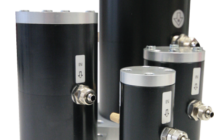By Shazla Mohamed1, Jon Palmer1, Graham Fletcher2, Steve Flint1
Fish is a highly nutritious food and an excellent source of proteins, vitamins, minerals and essential fatty acids. Hot smoked and dried fish are important parts of the traditionally accepted diet and a major source of protein for many in developing countries. “Maldive fish” is a hot smoked, salted and dried tuna which is a common ingredient used mainly for flavouring and thickening and forms the protein component of many dishes in the islands of the Maldives and neighbouring Sri Lanka. The reduced water content of the product, resulting from smoking and drying, limits the growth of microorganisms to some filamentous fungi (moulds). The association of fungal growth with smoked dried fish is well recognised. Many products including Maldive fish contain visible fungi on the surface.
Certain filamentous fungi are considered safe and have been intentionally used in the production of medicines and foods (cheeses, soybean paste, rice wine etc) while others cause food spoilage. However, most importantly, several fungi can produce toxic substances called mycotoxins. More than 100 toxigenic fungi and 300 mycotoxins from different food products have been reported (Keller et al., 2005). The toxicity of these substances varies widely with a range of acute and chronic health outcomes, the most important of which include various types of cancers and immunosuppression.
The implications are huge in terms of general health and even population mortality. For example, the number of deaths from liver cancer induced by aflatoxin consumption exceeds a staggering 20,000 per annum in Indonesia alone (Pitt, 2000). As with other food borne illnesses, it is likely that current statistics underestimate the numbers suffering ill health resulting from mycotoxin intake The microbiological safety of hot smoked dried fish has received little attention in contrast to the lightly smoked fish that are popular in developed nations. Hot smoked fish can add to the mycotoxin burden of developing countries which already experience increased exposure due to their less effective food control systems. Smoked dried fish from warmer climates have been reported to harbour many potentially toxigenic fungi and potent mycotoxins such as aflatoxins have been detected in some of these products. A PhD project recently completed at Massey University is the first study on the safety of Maldive fish (Mohamed, 2013). Such a study was needed to ensure a better quality product both in terms of revenue for the producer and health of the consumer. The project evaluated issues associated with the growth of toxigenic fungi and mycotoxin production in Maldive fish and determined measures for their control.
The initial aim of the PhD study was to determine whether Maldive fish supports the growth of toxigenic fungi and production of deleterious mycotoxins. The first step was to isolate and identify the fungi growing on the product as the natural mycoflora on the surface of Maldive fish had not been characterised previously. Twenty five samples with visible fungal growth were purchased from local markets in the capital island Malé, Maldives, over a period of three years. The fungi were isolated and identified using morphological methods following established taxonomic monographs. All samples were contaminated by filamentous fungi with 96 percent containing one or more mycotoxigenic species. Aspergillus flavus isolated from 92 percent of the samples is an important producer of the mycotoxin aflatoxin B, a potent liver carcinogen (Group I human carcinogen). The fungi also produce cyclopiazonic acid. In addition, four other species (Table 1) isolated were potential producers of important mycotoxins (Mohamed, 2013).
The next step of the study was to screen potentially toxigenic fungi for their corresponding toxins. This included developing and optimising a new screening method for the mycotoxin citrinin based on the characteristic fluorescence produced on coconut cream agar under UV light (Mohamed et al., 2013). This simple and rapid method was used to screen Penicillium citrinum isolates from Maldive fish for citrinin production but could also have a broader application of screening other potential citrinin producers.
A high proportion (72 percent) of potentially toxigenic isolates was able to produce mycotoxins on laboratory culture with almost half (46 percent) of the A. flavus isolates positive for aflatoxin B. The results indicate possible contamination of the product with mycotoxins if provided with a favourable environment including the nature of the product and storage conditions.
The product was therefore assessed for factors that may have an impact on fungal growth and mycotoxin production. The water activity of the product, a measure of water available for microbiological growth, was much more variable than expected (0.951 to 0.720) and could support a wide range of fungi. This reflects the lack of control of the drying process and the need to establish regulatory or industry controls.
None of the samples was found to be of a sufficiently low water activity to halt the growth of the toxigenic fungi isolated. Furthermore, the slightly acidic pH (5.65 to 6.68) and low salt content (1.48 to 4.29 percent) together with the high ambient temperatures of the tropics are eminently suitable for fungal growth and mycotoxin production.
At this stage in the study, the product was analysed for important mycotoxins using High Performance Liquid Chromatography. Tests confirmed that two of the 25 samples were contaminated with aflatoxin levels above the commonly applied legal limits of 2 ppb for aflatoxin B1 and 4 ppb for total aflatoxins (FAO, 2004). This is one of the most significant findings of the study and proves that Maldive fish supports the growth of toxigenic fungi and the production of mycotoxins. Maldive fish poses a risk to food safety and therefore this information needs to be communicated with consumers of the product. This will provide incentive to finalise and enforce the draft regulations covering the manufacture of Maldive fish.
These results led to the second question as to whether fungal growth and mycotoxin production in Maldive fish can be eliminated or reduced to safe levels. Possible approaches include the use of improved packaging or biological control by inoculation of fish with nontoxigenic strains. These would be expensive or require technical expertise which would add a burden to the small scale or cottage industries that are generally involved in the production of this product. The more practical approach would be to ensure that the water content of the product was reduced to sufficiently low levels to control growth and toxin production of A. flavus and other toxigenic fungi. The remaining objective of this study was to evaluate the effects of the important environmental parameters such as water activity and temperature on the growth and toxin production of the two most important fungal species A. flavus and A. tamarii, in order to determine the limiting conditions for their growth and mycotoxin production.
Studies on the physiology of A. tamarii are limited compared to the wide body of literature on A. flavus. Hence, the effect of environmental parameters on the germination and growth of A. tamarii on general media was studied. The limiting water activity for A. tamarii was between 0.82 and 0.85 on NaCl media and between 0.79 and 0.75 on media containing sugars at ambient storage temperatures (25 to 35°C). The latter values are more applicable to this product due to its low salt content. Hence, the water activity of Maldive fish should be maintained below 0.75 to prevent the growth of A. tamarii and avoid mycotoxin production (Mohamed et al., 2012).
A smoked fish agar was used to simulate Maldive fish for fungal growth (A. flavus) and mycotoxin production under varying conditions. The growth of A. flavus was observed down to 0.80 water activity at 30°C after incubation for 21 days but no growth occurred at 0.75. The production of aflatoxin and cyclopiazonic acid was limited at 0.80 water activity under all conditions. Hence, the main recommendation from this study is that Maldive fish should be dried rapidly to achieve a water activity of 0.75 or below (Mohamed, 2013).
A guideline limit of 0.75 water activity (translated to moisture content) should become part of the regulations for this product to achieve better control of fungal growth and mycotoxin production in Maldive fish. However, the practicality of consistently preparing a product with a specific water activity under artisanal conditions needs to be confirmed. In addition, exposure of the product to fungal spores should be minimised at all stages of production and storage. Measures must be taken to avoid reabsorption of moisture from the environment by controlling the humidity during storage. These requirements should also be part of the regulations. Based on the findings of this study regulatory limits should also be established for aflatoxins levels in Maldive fish.
In conclusion, this study has provided some scientific evidence that the mycoflora on Maldive fish produce aflatoxins and other mycotoxins that are a food safety risk. The favourable environmental conditions often present in this product, together with the toxin producing ability of a high proportion of strains isolated, can result in the contamination of the product with levels of aflatoxins above the recommended limits. Control of the growth of A. flavus and other toxigenic strains is therefore necessary and this could be achieved through adequate drying. This information is crucial for the Maldives as well as other developing countries that consume hot smoked dried fish or similar products. It is hoped that the results from this study can be used to prompt regulators and producers to develop and enforce standards and regulations for the manufacture of Maldive fish and to produce guidelines that can be practically implemented.
Refererences
FAO. (2004). Worldwide regulations for mycotoxins in food and feed in 2003. Rome: Food and Agriculture Organisation of the United Nations.
Keller, N. P., Turner, G., and Bennett, J. W. (2005). Fungal secondary metabolism – from biochemistry to genomics. Nature Reviews Microbiology, 3, 937-947.
Mohamed, S. (2013). Toxigenic Fungi and Mycotoxin Production in Maldive Fish, A Smoked Dried Tuna Fish. PhD thesis. Massey University, Palmerston North, New Zealand.
Mohamed, S., Mo, L., Flint, S., Palmer, J., and Fletcher, G. C. (2012). Effect of water activity and temperature on the germination and growth of Aspergillus tamarii isolated from “Maldive fish”. International Journal of Food Microbiology, 160, 119-123.
Mohamed, S., Flint, S., Palmer, J., Fletcher, G. C. and Pitt, J.I. (2013). A Simple Screening Method for Detection of Citrinin using Coconut Cream Agar. Letters in Applied Microbiology. Submitted.
Pitt, J. I. (2000). Toxigenic fungi and mycotoxins. British Medical Bulletin, 56, 184-192.
1 Institute of Food Nutrition and Human Health, Massey University, Palmerston North
2 Food Safety and Preservation, Seafood Technologies, New Zealand Institute for Plant & Food Research Limited, Auckland




























































































